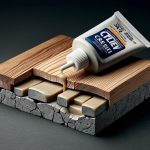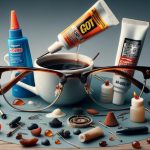Attaching acrylic to glass is a useful technique for various decorative and functional applications, from artistic projects to practical fixes.
Whether you’re looking to secure an acrylic sign to a glass window or bond decorative acrylic pieces to glass furniture, the process can be surprisingly straightforward yet requires some important considerations to ensure a strong and lasting bond.
So, can i stick acrylic on glass?
Yes, you can stick acrylic on glass, but it requires some preparation and the right materials. Here are the steps you can follow:
- Sand the Acrylic Surface: You’ll be bonding this to the glass.
- Clean Both Surfaces: Clean both the acrylic and glass surfaces with isopropyl alcohol.
- Glue the Pieces Together: Use a suitable adhesive to stick the acrylic to the glass.
If you’re referring to acrylic paint, it can stick to the bare glass surface as finished work is used only for decorative purposes without any scratching or contact of moisture2. For more abrasive uses, glass needs to be prepared by sanding, priming with an industrial primer, and gesso. Finally, seal with an acrylic clear coating.
Remember, the type of acrylic paint that works best on smooth surfaces, including glass, is acrylic enamel paint3. High-grade paint is not only easier to work with, but it also produces brighter colors and lasts longer.
By following these guidelines, you can achieve a durable and visually appealing acrylic-to-glass attachment. Whether you’re a hobbyist or a professional, these tips will help ensure your project’s success.
Table of Contents
Can You Use Acrylic Paint on Glass?
Yes, you can use acrylic paint on glass, but it requires specific techniques and materials to ensure the paint adheres well and lasts. Despite glass lacking the natural ‘tooth’ or texture needed for paint to cling effectively, there are ways to modify the surface to make it suitable for acrylics.
For those looking to use acrylic paint on glass surfaces, it’s pivotal to understand and apply the best methods to secure lasting results. Here are some top techniques:
| Technique | Description | Materials Needed |
|---|---|---|
| Surface Preparation | Clean the glass thoroughly to remove oils, dust, and debris. A well-prepared surface ensures better adhesion. | Alcohol wipes, soap, water |
| Using a Primer | Apply a primer designed for glossy surfaces to give the acrylic paint something to grip onto. | Glass or acrylic primer |
| Acrylic Paint Formulation | Choose acrylic enamel paint, which is better suited for glass surfaces, or add a glass medium to regular acrylic paint. | Acrylic enamel paint, glass medium |
| Sealing the Paint | Once the paint is dry, apply a sealant to protect the paint from peeling or chipping. | Clear acrylic sealant |
How to Find the Best Acrylic Paint for Glass
When seeking the best acrylic paint for glass application, several key factors should guide your choice.
These considerations are tailored to ensure the paint adheres well and retains its vibrancy on glass surfaces.
| Factor | Details | Why It Matters |
| Versatility | Ability to mimic other paint types like oils or watercolors. | Enables creative flexibility and a variety of visual effects on glass. |
| Drying Time | Fast drying to facilitate quicker layering. | Essential for building depth without smudging previous layers. |
| Quality | High pigment concentration and smooth application. | Ensures bright, lasting colors and professional finish. |
| Ease of Use | User-friendly, available in various forms like jars and pens. | Improves accessibility for artists of all skill levels. |
| Durability | Resistance to fading and weather elements. | Crucial for maintaining the integrity of artwork on display. |
| Budget and Experience | Options ranging from affordable to premium. | Allows selection based on personal or professional needs. |
| Types of Acrylics | Variations in thickness and texture. | Facilitates specific techniques and effects suited to glass. |
| Recommendations | Reviews and expert endorsements of brands. | Guides informed choices based on credible user experiences. |
For glass painting projects, prioritize acrylics that offer robust adhesion to avoid peeling and flaking. Look for products specifically formulated for glass or those that can be modified with a medium for better sticking properties.
Also, employing a primer or a sealant can enhance the durability of the paint, making your artwork resistant to elements and wear.
What Type of Paint to Use With Glass
Answer: The optimal choice for adhering acrylic to glass is enamel paint. Enamel paint excels in providing a durable, waterproof finish that adheres effectively to smooth surfaces like glass. This makes it highly suitable for projects involving both glass and acrylic, ensuring a robust bond and longevity.
| Type of Paint | Properties | Suitability for Glass |
| Enamel Paint | Waterproof, durable, designed for smooth surfaces | Highly suitable for glass, provides strong adhesion and durability |
| Glass Paint | Formulated specifically for glass, bonds well with acrylic | Excellent for detailed projects, ensures strong adhesion |
| Acrylic Enamel Paint | Combines acrylic and enamel benefits, versatile | Good for various designs, offers versatility and strong bonding |
How to Paint Glass With Acrylic Paint
To achieve a professional-looking finish when painting glass with acrylic paint, here’s a structured guide:
| Step | Action | Details |
| Clean the Glass | Thoroughly clean | Use glass cleaner or a mix of vinegar and water to remove all residues that might hinder paint adhesion. |
| Sand or Prep the Surface | Create texture | Lightly sand with fine-grit sandpaper or wipe with rubbing alcohol for better paint grip. |
| Apply Primer | Prime the surface | Use a primer designed for glass to enhance paint adhesion. Allow it to dry completely. |
| Select the Right Paint | Choose suitable acrylic paint | Opt for high-quality, glass-specific acrylic paints for better durability and adhesion. |
| Paint in Layers | Apply thin, even layers | Start with a base coat, letting each layer dry before applying the next. Use a hairdryer to speed up drying. |
| Use the Appropriate Brushes | Select brushes | Employ soft, synthetic bristle brushes for smooth application. Avoid foam brushes. |
| Detailing | Add fine details | Use a fine-tip brush for intricate designs, ensuring precision and control. |
| Curing | Let the paint cure | Allow the paint to cure for at least 24 hours to ensure full adhesion and durability. |
Additional Tips:
- Sealing: After the paint has cured, consider applying a clear acrylic sealer to protect the paint and enhance its glossiness.
- Testing: Before starting your project, test your method on a small area or a similar piece of glass to ensure compatibility and the desired outcome.
- Working Environment: Paint in a well-ventilated area to avoid inhaling fumes from the paint and primer.
How to Seal Acrylic Paint on Glass
To achieve a long-lasting and professional finish when sealing acrylic paint on glass, it’s essential to select the appropriate sealant and apply it correctly. Here’s a comprehensive guide structured to ensure clarity and effectiveness:
Step-by-Step Process:

- Clean the Glass Surface:
- Ensure the glass is free of dust, grease, and fingerprints. Use rubbing alcohol and a clean cloth to wipe it thoroughly.
- Apply Acrylic Paint:
- Use a suitable acrylic paint for glass. Apply it evenly and allow it to dry completely. For better adhesion, consider adding a bonding primer before painting.
- Choose the Right Sealant:
- For optimal durability and a professional appearance, use a water-based polyurethane or a specialized glass sealant.
Recommended Sealants:
| Sealant Type | Advantages | Application Method |
| Water-Based Polyurethane | Non-yellowing, provides a durable coat, safe to use indoors. | Brush on evenly with a soft brush. |
| Acrylic Enamel Sealant | Specifically designed for glass, offers excellent adhesion. | Can be sprayed or brushed on. |
| Epoxy Resin | Extremely durable, ideal for tabletops and jewelry. | Mix as directed and pour over the surface. |
Application Tips:
- Apply Evenly: Use a soft brush or a sponge applicator to apply the sealant. Avoid over-application to prevent drips.
- Multiple Coats: For surfaces that will be handled frequently, such as wine glasses or ornaments, apply at least two coats of sealant, allowing proper drying time between coats.
- Cure Time: Allow the sealant to cure fully according to the manufacturer’s instructions—typically 24 hours in a dust-free environment.
Additional Recommendations:
- Test First: Before starting your main project, test the paint and sealant on a small area of glass to ensure compatibility and the desired finish.
- Ventilation: Work in a well-ventilated area to avoid inhaling fumes from the sealant.
By following these guidelines, you will ensure that your painted glass items are not only beautiful but also durable and professionally finished.
Techniques, Tips, and Tricks for Using Acrylic Paint on Glass
When applying acrylic paint to glass, several techniques can be used to ensure a robust and enduring bond. Below, we explore these techniques through a detailed approach:
| Technique | Description | Benefits |
|---|---|---|
| Cleaning and Sanding | Begin by thoroughly cleaning the glass with rubbing alcohol to remove any grease, dirt, or residues. After drying, lightly sand the glass surface with fine-grit sandpaper to create a rougher texture which helps in bonding. | Ensures clean surface, enhances paint adhesion |
| Using a Glass Primer | Apply a primer designed specifically for glass. This primer forms a sticky base that significantly improves the adherence of acrylic paints. | Optimizes paint adhesion, reduces paint peeling |
| Choosing the Right Paint | Select enamel-based acrylic paints for best results on glass surfaces. These paints are formulated for use on non-porous surfaces, offering better durability and adhesion. | Enhances durability, adheres better without priming |
| Layering and Curing | Apply the paint in thin, even layers, allowing each layer to dry thoroughly. For a more durable finish, the painted glass can be cured in an oven as per the paint manufacturer’s instructions. | Builds paint strength, heat curing offers long-lasting durability |
| Sealing the Paint | Once the painting is complete and fully dry, apply a clear acrylic sealer over the surface. This sealer protects the paint from moisture, chipping, and fading. | Protects against environmental factors, prolongs life of artwork |
To achieve the best results, follow these tips:
- Use Tapes and Stencils: To create crisp lines and intricate patterns, use painter’s tape or stencils. This will also help in creating multi-coloured designs with precision.
- Experiment with Techniques: Try different painting techniques such as sponging, stippling, or layering to add texture and depth to your designs.
- Maintain Proper Care: Handle the painted glass with care. Avoid using abrasive cleaners that can scratch or peel the paint.






